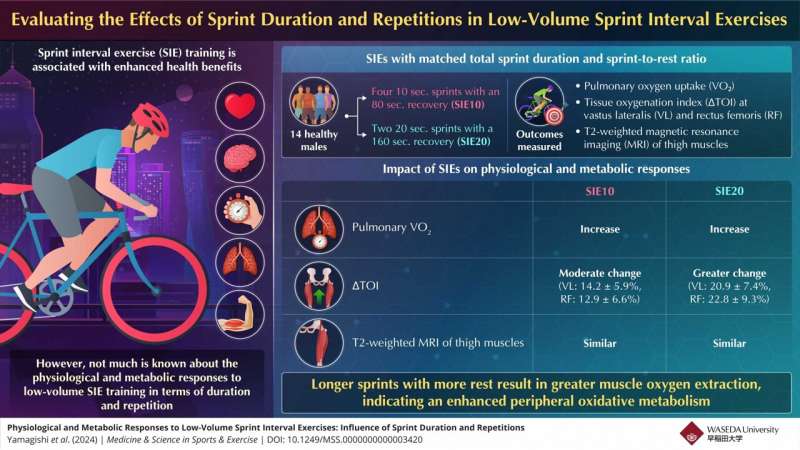This article has been reviewed according to Science X's editorial process and policies. Editors have highlighted the following attributes while ensuring the content's credibility:
fact-checked
peer-reviewed publication
trusted source
proofread
Longer sprint intervals can improve muscle oxygen utilization compared to shorter intervals

Physical activities like jogging, walking, cycling, and sprinting are activities known to engage the musculoskeletal system and result in the utilization of energy. Sprint interval training (SIT) is a type of sprinting exercise that involves cycles of intense exercise followed by a short duration of rest. How the durations of exercise and rest are structured can affect the impact of SIT on physiological responses.
In recent years, the field of sports physiology has witnessed increased interest in optimizing SIT protocols. This surge can enhance the recognition of SIT's efficacy in improving athletic performance and overall well-being, highlighting its versatility as a tool for promoting health and fitness.
Now, in an effort to highlight the benefits of SIT, a team of researchers from Japan, comprising Dr. Takaki Yamagishi from the Department of Sport Science and Research, Japan Institute of Sports Sciences and Human Performance Laboratory at the Comprehensive Research Organization at Waseda University, and Professor Yasuo Kawakami who directs the Human Performance Lab and is from the Faculty of Sport Sciences, Waseda University, conducted SIT experiments with healthy human volunteers in a recent study.
The study is published in the Medicine & Science in Sports & Exercise journal.
Explaining the motivation behind their research work, Yamagishi says, "Establishing a minimum dose of exercise training to bring about training benefits, such as aerobic fitness, has been one of my main research interests. Due to the support from Prof. Kawakami and other co-authors, along with the collaboration with Waseda University, this unique research work using a multifaceted approach was possible."
The team of researchers matched two different sprint interval exercises (SIE) for the total duration of sprint and sprint-to-rest ratio. They analyzed the influence of SIE on physiological and metabolic responses by examining pulmonary oxygen uptake (V̇O2) levels and changes in tissue oxygenation index (∆TOI) in thigh muscles. Additionally, they utilized the T2-weighted magnetic resonance imaging (MRI) technique to assess the activation of thigh muscles.
The researchers highlight that SIE20, comprising of two 20-second sprints with 160-second recovery, outperformed SIE10, which involved four 10-second sprints with 80-second recovery. While both the SIE protocols significantly increased whole-body and peripheral oxidative metabolism and the activation of the major thigh muscles, as indicated by the increases in V̇O2 levels, ∆TOI and MRI T2 values, respectively, greater peripheral oxidative metabolism was achieved with SIE20. They also observed that successive sprint repetitions in SIE10 did not correlate with greater oxidative metabolism.
Elaborating on the real-life applications and impact of the present research, Yamagishi says, "In today's fast-moving world, lack of time is a major hindrance to regular physical activity. However, the exercise modalities employed in our study require less than 15 minutes to complete and provide considerable health benefits."
In summary, the findings from this study can address important research gaps in SIT, such as the effects of minimum sprint duration and repetitions on aerobic and metabolic responses in humans. In-depth studies on low-volume SIT have the potential to improve training programs and exercise regimens.
Yamagishi says, "Exercise guidelines proposed by major organizations such as the American College of Sports Medicine are updated every five to 10 years, and we are hopeful that our study can be a part of it. Future studies on SIE can build on our findings to establish the dose-response relationship between exercise volume or intensity and the degree of training adaptations."
More information: Takaki Yamagishi et al, Physiological and Metabolic Responses to Low-Volume Sprint Interval Exercises: Influence of Sprint Duration and Repetitions, Medicine & Science in Sports & Exercise (2024). DOI: 10.1249/MSS.0000000000003420




















